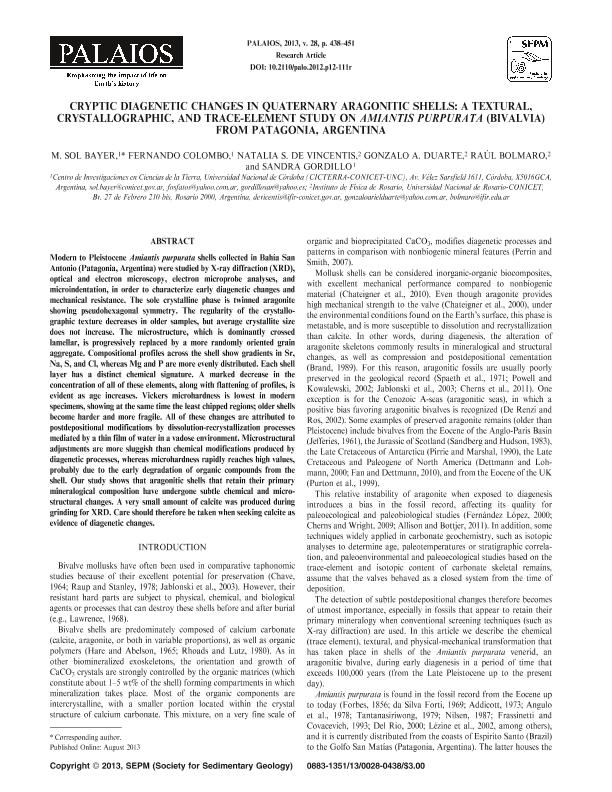Artículo
Cryptic Diagenetic Changes in Quaternary Aragonitic Shells: A Textural, Crystallographic, and Trace-Element Study on Amiantis Purpurata (Bivalvia) From Patagonia, Argentina
Bayer, María Sol ; Colombo, Fernando
; Colombo, Fernando ; de Vincentis, Natalia Soledad
; de Vincentis, Natalia Soledad ; Duarte, Gonzalo; Bolmaro, Raul Eduardo
; Duarte, Gonzalo; Bolmaro, Raul Eduardo ; Gordillo, Sandra
; Gordillo, Sandra
 ; Colombo, Fernando
; Colombo, Fernando ; de Vincentis, Natalia Soledad
; de Vincentis, Natalia Soledad ; Duarte, Gonzalo; Bolmaro, Raul Eduardo
; Duarte, Gonzalo; Bolmaro, Raul Eduardo ; Gordillo, Sandra
; Gordillo, Sandra
Fecha de publicación:
08/2013
Editorial:
Geo Science World
Revista:
Palaios
ISSN:
0883-1351
Idioma:
Inglés
Tipo de recurso:
Artículo publicado
Clasificación temática:
Resumen
Modern to Pleistocene Amiantis purpurata shells collected in Bahı´a San Antonio (Patagonia, Argentina) were studied by X-ray diffraction (XRD), optical and electron microscopy, electron microprobe analyses, and microindentation, in order to characterize early diagenetic changes and mechanical resistance. The sole crystalline phase is twinned aragonite showing pseudohexagonal symmetry. The regularity of the crystallographic texture decreases in older samples, but average crystallite size does not increase. The microstructure, which is dominantly crossed lamellar, is progressively replaced by a more randomly oriented grain aggregate. Compositional profiles across the shell show gradients in Sr, Na, S, and Cl, whereas Mg and P are more evenly distributed. Each shell layer has a distinct chemical signature. A marked decrease in the concentration of all of these elements, along with flattening of profiles, is evident as age increases. Vickers microhardness is lowest in modern specimens, showing at the same time the least chipped regions; older shells become harder and more fragile. All of these changes are attributed to postdepositional modifications by dissolution-recrystallization processes mediated by a thin film of water in a vadose environment. Microstructural adjustments are more sluggish than chemical modifications produced by diagenetic processes, whereas microhardness rapidly reaches high values,probably due to the early degradation of organic compounds from the shell. Our study shows that aragonitic shells that retain their primary mineralogical composition have undergone subtle chemical and microstructural changes. A very small amount of calcite was produced during grinding for XRD. Care should therefore be taken when seeking calcite as evidence of diagenetic changes.
Palabras clave:
Mollusca
,
Quaternary
,
Amiantis Purpurata
,
Diagenesis
Archivos asociados
Licencia
Identificadores
Colecciones
Articulos(CICTERRA)
Articulos de CENTRO DE INVEST.EN CS.DE LA TIERRA
Articulos de CENTRO DE INVEST.EN CS.DE LA TIERRA
Articulos(IFIR)
Articulos de INST.DE FISICA DE ROSARIO (I)
Articulos de INST.DE FISICA DE ROSARIO (I)
Citación
Bayer, María Sol; Colombo, Fernando; de Vincentis, Natalia Soledad; Duarte, Gonzalo; Bolmaro, Raul Eduardo; et al.; Cryptic Diagenetic Changes in Quaternary Aragonitic Shells: A Textural, Crystallographic, and Trace-Element Study on Amiantis Purpurata (Bivalvia) From Patagonia, Argentina; Geo Science World; Palaios; 28; 7; 8-2013; 438-451
Compartir
Altmétricas



